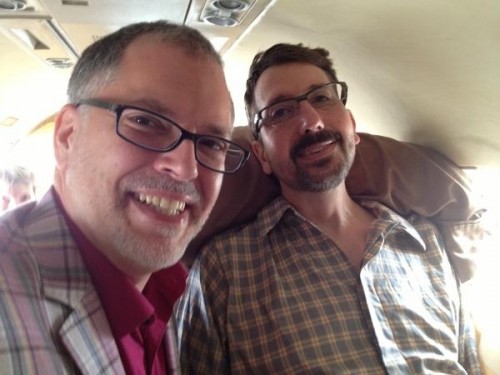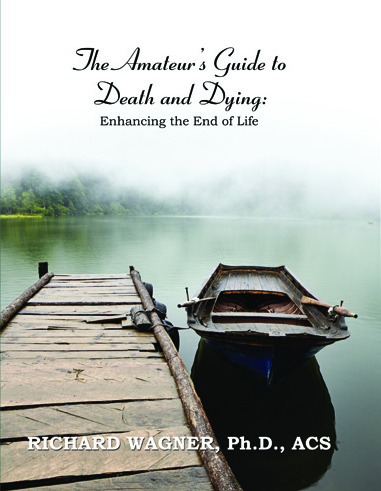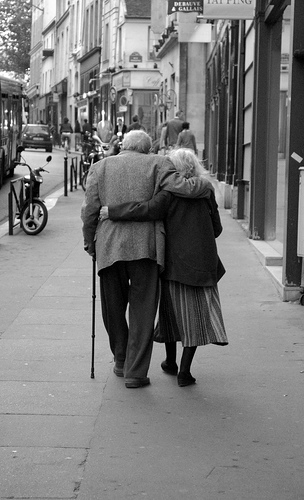Crossroads Hospice offers the gift of a perfect day to its patients, a chance for the dying to do something they’ve always dreamed of. One man asked to ride an Indian motorcycle for his 100th birthday; an extended family went on a bus tour to view Christmas lights; a woman flew to Florida to stick her feet in the sand one last time, then died three hours after she came home.
John Arthur’s been a patient of Crossroads since March, but it wasn’t until June 26 that he settled on his notion of a perfect day. That morning the U.S. Supreme Court struck down portions of the federal Defense of Marriage Act. As he watched the announcement from a medical bed in his Over-the-Rhine condo, Arthur and his partner of 20 years, Jim Obergefell, decided that they wanted to marry.
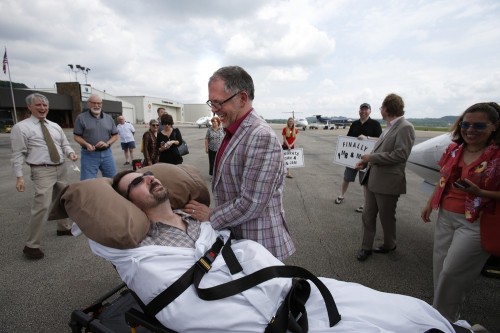 A wedding for the couple would not be easy. Because same-sex marriage is illegal in Ohio, and because the Supreme Court ruling left marriage bans at the state level intact, Arthur and Obergefell couldn’t marry here. The prospect of travel was difficult because Arthur is bedridden with amyotrophic lateral sclerosis, or ALS, a progressive neurological disease that robs patients of their ability to walk, talk and eventually breathe. Within minutes of the Supreme Court decision, the couple started working the phones, email and social media to figure out how they might legally wed.
A wedding for the couple would not be easy. Because same-sex marriage is illegal in Ohio, and because the Supreme Court ruling left marriage bans at the state level intact, Arthur and Obergefell couldn’t marry here. The prospect of travel was difficult because Arthur is bedridden with amyotrophic lateral sclerosis, or ALS, a progressive neurological disease that robs patients of their ability to walk, talk and eventually breathe. Within minutes of the Supreme Court decision, the couple started working the phones, email and social media to figure out how they might legally wed.
New York was the closest to drive to, but they’d both need to be there for the license and return for the wedding. Out, they decided.
California and Washington, and the knot of northeastern states that have legalized same-sex marriage, were too far.
Maryland required only one partner to come for the license. Then a 48-hour waiting period.
It was an hour and 10-minute flight.
This might work, they decided: A destination wedding in Baltimore.
Then there was the cost.
Arthur has been unable to leave the couple’s home since March, and he’d need a medical transport plane that could accommodate a stretcher. Though hospice could provide some services, like the ambulance ride to the airport, it couldn’t cover the $12,700 cost of renting such a plane.
Obergefell asked friends if they had any connections. Instead donations poured in from relatives, friends, former co-workers, even someone in Ireland they’d met on a cruise. They covered enough of the cost to make the trip possible.
Obergefell flew to Baltimore on Tuesday, obtained the marriage license and flew back a few hours later.
And then on Thursday Arthur and Obergefell boarded a Lear jet at Lunken Airport with a nurse, two pilots trained in emergency medicine, and Arthur’s aunt, Paulette Roberts, who’d been ordained to perform weddings with the hope that she’d someday get to do theirs.
They touched down in Baltimore at 10:39 a.m. The plane parked off the runway and the pilots stepped outside.
And then, in the cramped cabin of the jet, Obergefell seated next to Arthur’s stretcher, the couple turned to each other and held hands. Roberts sat behind them and began to speak.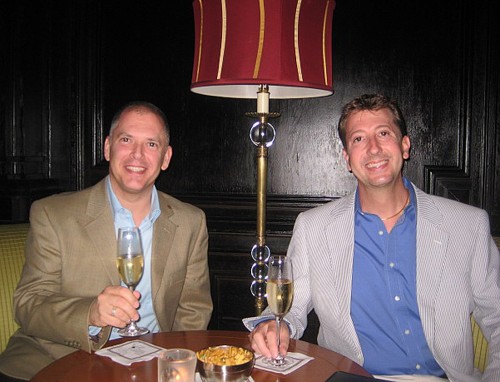
“When I obtained ordination and license to marry people, I called my nephew John and told him I would go anywhere, anytime to officiate at his and Jim’s marriage,” she said. “He and Jim both said no. They were married to each other in their eyes, but that they would not take part in a wedding ceremony until the law of the land declared they were equal to other couples.”
“Twenty-six months ago John was diagnosed with ALS,” she continued. “Since then the amazing relationship between John and Jim has become even closer, even more devoted, even more loving – and it was pretty damn great before John became ill.”
Obergefell spoke, choking back tears. They exchanged rings. Roberts pronounced them husband and husband, and Obergefell leaned over to Arthur and kissed him.
“Let us all rejoice,” Roberts said, as she leaned forward to hug them both. “I love you very much.”
“That was beautiful,” Arthur responded, his voice thickened and slowed by his disease. “And thank you for including the word ‘damn.’ ”
The 7 1/2 minute ceremony was over, and as they celebrated with Champagne, the pilots climbed back in and prepared to leave. After 56 minutes on the ground they were headed back to Cincinnati, matching rings on their left hands, finally married after 20 years, six months and 11 days together.
“I’m overjoyed,” Arthur said. “I’m very proud to be an American and be able to openly share my love for the record. I feel like the luckiest guy in the world.”
Arthur and Obergefell’s story is a dramatic example of what gay couples who live in states that don’t recognize same-sex marriage are experiencing in the wake of the Supreme Court’s DOMA decision. Trapped between federal law that recognizes such unions and state laws that don’t, they are unsure what their next move should be.
Like Arthur and Obergefell, many of them never expected to have a chance to wed in their lifetimes. But now with the prospect of marriage so close, they are impatient with the prospect of waiting still longer for their state to allow it.
Arthur’s terminal illness added urgency to the questions that many gay couples without the protection of marriage grapple with. Ask such couples why they want to get married, and after the jokes about housewares and bridesmaids subside, the talk often turns to the dark what-ifs that reside at the end of life.
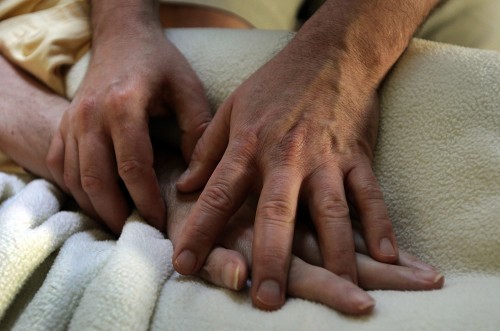 What if my partner’s in cardiac arrest and the emergency-room staff won’t let me in? What if my partner’s family challenges my custody of our son after she’s gone? What if, as in the case of the DOMA plaintiff, my partner dies and I owe $363,000 in estate taxes instead of the nothing that a heterosexual spouse would owe?
What if my partner’s in cardiac arrest and the emergency-room staff won’t let me in? What if my partner’s family challenges my custody of our son after she’s gone? What if, as in the case of the DOMA plaintiff, my partner dies and I owe $363,000 in estate taxes instead of the nothing that a heterosexual spouse would owe?
Arthur’s ALS diagnosis intruded on the life the couple had carefully built together over two decades. Though they met twice, rather unremarkably, through a friend in 1992, at Arthur’s New Year’s Eve party that year they experienced what they call “love at third sight.” Within seven weeks they had exchanged rings, and that summer they moved in together. “Jim came to our wild New Year’s Eve party,” Arthur said, “and he never left.”
Through new houses, job changes and extensive travel, they accumulated dozens of close friends and enjoyed the company of family. As same-sex marriage became legal in a handful of states, people asked if they’d considered going somewhere to marry, but the notion of a symbolic ceremony with no tangible benefit didn’t appeal to them. Even less appealing was the idea of moving somewhere new simply to enjoy the right to be married.
“Jim and I met here in Cincinnati. We have established our friends and family circle here,” says Arthur. “Even though we thrive on local conflicts and the absurdity of what happens in the great state of Ohio, we’ve never seriously considered moving because to move we wouldn’t have our social base. So it’s never been a real consideration.”
“And we both love Cincinnati. It’s a great city to live in,” adds Obergefell, who works as a consultant for an IT company. “We can’t imagine living anywhere else. And leaving the support network we have wasn’t really an option. Since his diagnosis that’s been even more important because our friends our family have been unbelievably supportive and helpful, and it’s made this horrible situation with ALS much more bearable, and enjoyable, amazingly enough.”
In the two-plus years since the diagnosis, Arthur has progressed from a cane to a walker to a manual wheelchair and then a motorized one. For a time the couple drove a minivan, a vehicle they never dreamed they’d own, because it was easier for John to get in and out of it. Since the spring they’ve relied on friends to come by for visits, as leaving the house finally became too difficult.
They’ve been touched by small kindnesses at every turn: Arthur’s former babysitter who’s corresponded regularly with him, a friend’s five-year-old who drew a picture of the couple that’s now framed on the wall, the friends who’ve shown up en masse for a brief hour or two of levity.
The couple, both 47, belong to a sandwich generation when it comes to gay rights, wedged between previous generations who were often firmly closeted, and younger gays and lesbians who have grown up seeing same-sex couples on television. Arthur and Obergefell say they’ve never known discrimination personally, never had a family member reject them because of their sexual orientation, never considered it more than a small part of who they are.
“We’ve always been out at work,” Arthur said. “But we’ve never been our own personal Pride parade either,” Obergefell added.
But the lack of a marriage license took on new meaning in light of the ALS diagnosis. The disease attacks the nerve cells that control the muscles we move voluntarily. As the nerve cells die, patients are unable to move their arms or legs; eventually the muscles that control breathing are also affected. It is a cruel and relentless disease that kills most patients between two and five years after diagnosis. There is no cure.
Arthur’s symptoms began innocently enough in the spring of 2011, with a left foot that seemed to drag and slap. The couple was preparing for a trip to Finland to visit exchange students they’d hosted. When they returned he went to their primary-care doctor, who sent him to a neurologist. Though there is no definitive test for ALS, the neurologist eliminated other possibilities and told Arthur his conclusion.
“I had no idea that would be the diagnosis. It caught me by surprise,” he says, tearing up at the memory. “I just remember I came in the door and turned to Jim and said, ‘I have ALS.’ Without even anything close to a full understanding of the implications, it was a very painful moment.”
Health insurance had been an ongoing issue for the couple, as some employers allowed them to share a policy and others didn’t. But insurance and other health-related matters suddenly took on added significance. Still reeling from the news, they had to prepare powers of attorney and other legal documents designed to circumvent the kinds of problems every unmarried couple fears.
They decided to sell their two-story condo and move to a single story, and they put the new place in Obergefell’s name alone to avoid any future probate problems. Obergefell’s employer has allowed him to work from home, but he has had no protection under the federal Family Medical Leave Act.
It’s unclear whether that will change now that they are married. No one knows what federal benefits couples would qualify for if they live in states that don’t recognize their marriages. Some benefits are granted based on where a couple lives, and others on where they were married. Leaving a state of residence that bans gay marriage to marry in one that allows it could further complicate things. The federal government is working now to untangle the confusion, but it could be years before it’s all sorted out.
Critics of allowing same-sex marriage argue that there are ways to extend legal protections to couples, to make sure they are never shut out of a partner’s hospital room or taxed extra because of their status, without changing the meaning that marriage has held for centuries. They want to create a “separate but equal” category for gay couples, a strategy that’s never succeeded in other questions of civil rights.
But in addition to rights, there is the question of recognition. To have one’s relationship viewed as equal to those of straight couples, to be able to check “married” on surveys and tax returns, is as important as the rights and protections that a valid marriage confers.
“In our minds we’ve always been married, but now I can actually say John’s my husband and have a piece of paper, and a Supreme Court ruling, and a federal government that says yes, he is your husband,” said Obergefell. “I’m overjoyed that we’ll now have a piece of paper that confirms what we’ve always known in our hearts – that we’re an old, married couple who still love each other.”
Next year Ohioans will likely have the chance to vote on whether to repeal the 2004 ban on gay marriage and allow same-sex couples to marry here. There are economic arguments in favor of repealing the ban, as many large companies prefer an environment in which all their employees enjoy the same rights. There is the argument that society benefits when it encourages loving, committed relationships and helps them flourish. And as Ohio combats brain drain, repealing the ban on same-sex marriage could help make the state more attractive to the many young adults who now leave for urban centers out of state.
But we believe this is the strongest argument of all: That couples who are already fulfilling the responsibilities of marriage, caring for each other in sickness and in health, should enjoy the privileges of marriage as well. They should be able to depend on the rights that many of us take for granted. They should be able to raise their children without having to carry adoption papers on a flash drive around their neck, and own property together without worry of what will happen to it upon death. They should be able to marry in the presence of family and friends, no matter where they live, and finally feel like full citizens no matter whom they love.
Complete Article HERE!



